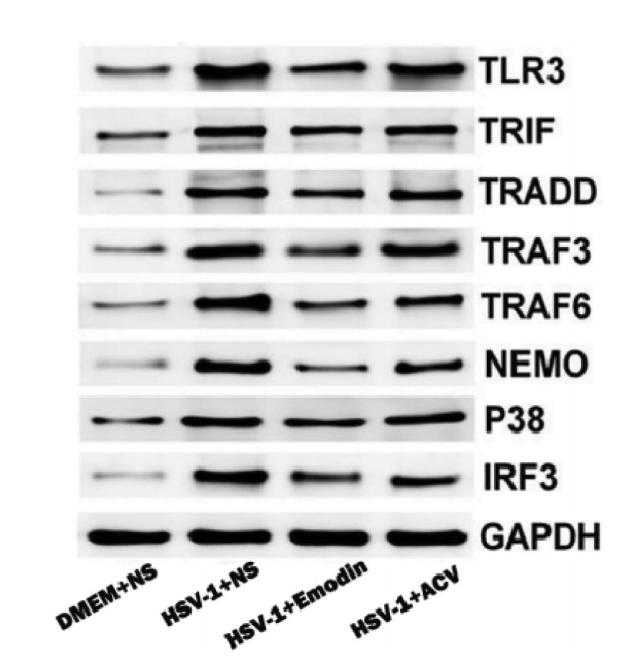| 产品: | TLR3 抗体 |
| 货号: | DF6415 |
| 描述: | Rabbit polyclonal antibody to TLR3 |
| 应用: | WB IHC |
| 反应: | Human, Mouse, Rat |
| 预测: | Bovine, Horse, Sheep, Rabbit |
| 分子量: | 99kDa,130kd(Glycosylation); 104kD(Calculated). |
| 蛋白号: | O15455 |
| RRID: | AB_2838378 |
产品描述
*The optimal dilutions should be determined by the end user.
*Tips:
WB: 适用于变性蛋白样本的免疫印迹检测. IHC: 适用于组织样本的石蜡(IHC-p)或冰冻(IHC-f)切片样本的免疫组化/荧光检测. IF/ICC: 适用于细胞样本的荧光检测. ELISA(peptide): 适用于抗原肽的ELISA检测.
引用格式: Affinity Biosciences Cat# DF6415, RRID:AB_2838378.
展开/折叠
CD283; CD283 antigen; IIAE2; TLR 3; Tlr3; TLR3_HUMAN; Toll Like Receptor 3; Toll-like receptor 3;
抗原和靶标
Expressed at high level in placenta and pancreas. Also detected in CD11c+ immature dendritic cells. Only expressed in dendritic cells and not in other leukocytes, including monocyte precursors. TLR3 is the TLR that is expressed most strongly in the brain, especially in astrocytes, glia, and neurons.
- O15455 TLR3_HUMAN:
- Protein BLAST With
- NCBI/
- ExPASy/
- Uniprot
MRQTLPCIYFWGGLLPFGMLCASSTTKCTVSHEVADCSHLKLTQVPDDLPTNITVLNLTHNQLRRLPAANFTRYSQLTSLDVGFNTISKLEPELCQKLPMLKVLNLQHNELSQLSDKTFAFCTNLTELHLMSNSIQKIKNNPFVKQKNLITLDLSHNGLSSTKLGTQVQLENLQELLLSNNKIQALKSEELDIFANSSLKKLELSSNQIKEFSPGCFHAIGRLFGLFLNNVQLGPSLTEKLCLELANTSIRNLSLSNSQLSTTSNTTFLGLKWTNLTMLDLSYNNLNVVGNDSFAWLPQLEYFFLEYNNIQHLFSHSLHGLFNVRYLNLKRSFTKQSISLASLPKIDDFSFQWLKCLEHLNMEDNDIPGIKSNMFTGLINLKYLSLSNSFTSLRTLTNETFVSLAHSPLHILNLTKNKISKIESDAFSWLGHLEVLDLGLNEIGQELTGQEWRGLENIFEIYLSYNKYLQLTRNSFALVPSLQRLMLRRVALKNVDSSPSPFQPLRNLTILDLSNNNIANINDDMLEGLEKLEILDLQHNNLARLWKHANPGGPIYFLKGLSHLHILNLESNGFDEIPVEVFKDLFELKIIDLGLNNLNTLPASVFNNQVSLKSLNLQKNLITSVEKKVFGPAFRNLTELDMRFNPFDCTCESIAWFVNWINETHTNIPELSSHYLCNTPPHYHGFPVRLFDTSSCKDSAPFELFFMINTSILLIFIFIVLLIHFEGWRISFYWNVSVHRVLGFKEIDRQTEQFEYAAYIIHAYKDKDWVWEHFSSMEKEDQSLKFCLEERDFEAGVFELEAIVNSIKRSRKIIFVITHHLLKDPLCKRFKVHHAVQQAIEQNLDSIILVFLEEIPDYKLNHALCLRRGMFKSHCILNWPVQKERIGAFRHKLQVALGSKNSVH
种属预测
score>80的预测可信度较高,可尝试用于WB检测。*预测模型主要基于免疫原序列比对,结果仅作参考,不作为质保凭据。
High(score>80) Medium(80>score>50) Low(score<50) No confidence
翻译修饰 - O15455 作为底物
| Site | PTM Type | Enzyme | Source |
|---|---|---|---|
| N52 | N-Glycosylation | Uniprot | |
| N57 | N-Glycosylation | Uniprot | |
| N70 | N-Glycosylation | Uniprot | |
| T72 | Phosphorylation | Uniprot | |
| N124 | N-Glycosylation | Uniprot | |
| N196 | N-Glycosylation | Uniprot | |
| S205 | Phosphorylation | Uniprot | |
| S206 | Phosphorylation | Uniprot | |
| N247 | N-Glycosylation | Uniprot | |
| N252 | N-Glycosylation | Uniprot | |
| N265 | N-Glycosylation | Uniprot | |
| N275 | N-Glycosylation | Uniprot | |
| N291 | N-Glycosylation | Uniprot | |
| S350 | Phosphorylation | Uniprot | |
| Y383 | Phosphorylation | Uniprot | |
| T391 | Phosphorylation | Uniprot | |
| S392 | Phosphorylation | Uniprot | |
| N398 | N-Glycosylation | Uniprot | |
| N413 | N-Glycosylation | Uniprot | |
| N507 | N-Glycosylation | Uniprot | |
| N636 | N-Glycosylation | Uniprot | |
| Y759 | Phosphorylation | P12931 (SRC) | Uniprot |
| T818 | Phosphorylation | Uniprot | |
| Y858 | Phosphorylation | P00533 (EGFR) | Uniprot |
研究背景
Key component of innate and adaptive immunity. TLRs (Toll-like receptors) control host immune response against pathogens through recognition of molecular patterns specific to microorganisms. TLR3 is a nucleotide-sensing TLR which is activated by double-stranded RNA, a sign of viral infection. Acts via the adapter TRIF/TICAM1, leading to NF-kappa-B activation, IRF3 nuclear translocation, cytokine secretion and the inflammatory response.
Heavily N-glycosylated, except on that part of the surface of the ectodomain that is involved in ligand binding.
TLR3 signaling requires a proteolytic cleavage mediated by cathepsins CTSB and CTSH, the cleavage occurs between amino acids 252 and 346. The cleaved form of TLR3 is the predominant form found in endosomes.
Endoplasmic reticulum membrane>Single-pass type I membrane protein. Endosome membrane. Early endosome.
Expressed at high level in placenta and pancreas. Also detected in CD11c+ immature dendritic cells. Only expressed in dendritic cells and not in other leukocytes, including monocyte precursors. TLR3 is the TLR that is expressed most strongly in the brain, especially in astrocytes, glia, and neurons.
Monomer and homodimer; dimerization is triggered by ligand-binding, the signaling unit is composed of one ds-RNA of around 40 bp and two TLR3 molecules, and lateral clustering of signaling units along the length of the ds-RNA ligand is required for TLR3 signal transduction. Interacts (via transmembrane domain) with UNC93B1; the interaction is required for transport from the ER to the endosomes. Interacts with SRC; upon binding of double-stranded RNA. Interacts with TICAM1 (via the TIR domain) in response to poly(I:C) and this interaction is enhanced in the presence of WDFY1. The tyrosine-phosphorylated form (via TIR domain) interacts with WDFY1 (via WD repeat 2) in response to poly(I:C).
ds-RNA binding is mediated by LRR 1 to 3, and LRR 17 to 18.
Belongs to the Toll-like receptor family.
研究领域
· Cellular Processes > Cell growth and death > Necroptosis. (View pathway)
· Human Diseases > Infectious diseases: Viral > Hepatitis C.
· Human Diseases > Infectious diseases: Viral > Hepatitis B.
· Human Diseases > Infectious diseases: Viral > Influenza A.
· Human Diseases > Infectious diseases: Viral > Human papillomavirus infection.
· Human Diseases > Infectious diseases: Viral > Herpes simplex infection.
· Organismal Systems > Immune system > Toll-like receptor signaling pathway. (View pathway)
文献引用
Application: WB Species: mouse Sample: macrophages
Application: IF/ICC Species: mouse Sample: nuclei
Application: WB Species: mouse Sample: brain
Application: IHC Species: mouse Sample: right temporal lobe brain
Application: WB Species: Mice Sample: brain tissues
限制条款
产品的规格、报价、验证数据请以官网为准,官网链接:www.affbiotech.com | www.affbiotech.cn(简体中文)| www.affbiotech.jp(日本語)产品的数据信息为Affinity所有,未经授权不得收集Affinity官网数据或资料用于商业用途,对抄袭产品数据的行为我们将保留诉诸法律的权利。
产品相关数据会因产品批次、产品检测情况随时调整,如您已订购该产品,请以订购时随货说明书为准,否则请以官网内容为准,官网内容有改动时恕不另行通知。
Affinity保证所销售产品均经过严格质量检测。如您购买的商品在规定时间内出现问题需要售后时,请您在Affinity官方渠道提交售后申请。产品仅供科学研究使用。不用于诊断和治疗。
产品未经授权不得转售。
Affinity Biosciences将不会对在使用我们的产品时可能发生的专利侵权或其他侵权行为负责。Affinity Biosciences, Affinity Biosciences标志和所有其他商标所有权归Affinity Biosciences LTD.





